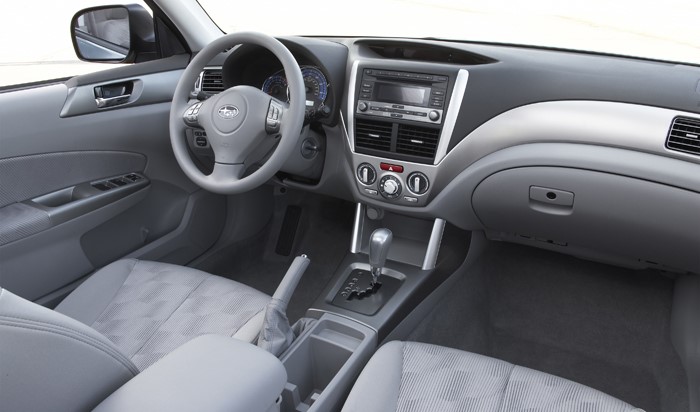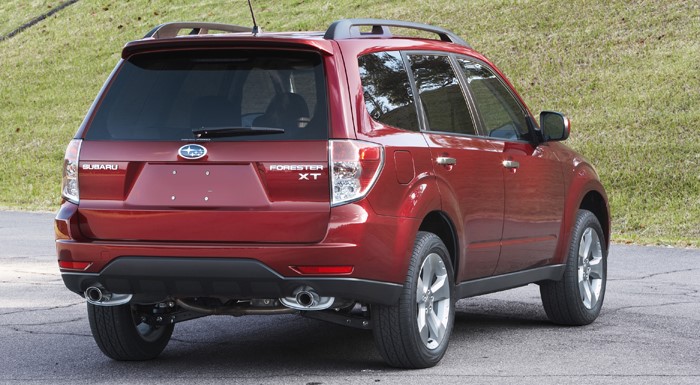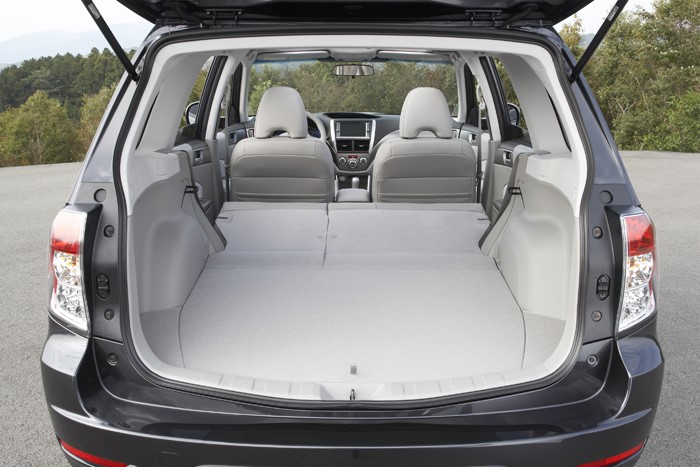
- All-New Design with Improved Comfort, Space and Utility
- All-New Platform With Sport-Sedan Dynamics
- Standard Vehicle Dynamics Control (VDC)
The all-new, third-generation 2009 Forester. A total re-design of the award winning Forester, a vehicle that has built a strong reputation as an icon of safety, dependability and versatility. The 2009 Subaru Forester builds upon that reputation, with a bolder, more SUV-like design, and it makes a major leap in safety technology, comfort, refinement and driving dynamics – a noteworthy accomplishment considering the high standards set by the previous model.
The 2009 Forester arrives in Subaru dealerships this spring. As with all Subaru models, the 2009 Forester comes equipped as standard with Symmetrical All-Wheel Drive. The new-generation 2009 Forester again blends positive SUV attributes including a high seating point and interior versatility with passenger car comfort, handling and fuel efficiency.
The 2009 Forester is built on an all-new platform featuring a 3.6-inch longer wheelbase (now 103.0 inches) that improves ride and interior space, especially rear seat legroom. The 2009 Forester also features increased hip and shoulder room. In addition, the new platform improves crash-worthiness and provides a stiffer platform for crisper handling. A new double-wishbone rear suspension, mounted to a sub frame, replaces the previous strut-type configuration to provide improved ride and handling and increased cargo room. The enhancement of body rigidity and new suspension help reduce levels of Noise, Vibration, and Harshness (NVH).
All Forester models for 2009 feature standard side-curtain airbags with a rollover sensor, and the Vehicle Dynamics Control (VDC) stability and traction control system is standard on all models for the first time. With the Subaru Dynamic Chassis Control Concept (Subaru DC3), Subaru optimized all elements of the Forester’s chassis to deliver a better balance of ride, handling response, quietness and overall traction performance than offered by competitive vehicles.
A comprehensive array of elements contributes to that goal, including the new, high-strength body structure, standard Symmetrical All-Wheel Drive, VDC and four-wheel disc ABS brakes with the Brake Assist safety system. Manual-transmission models also feature Incline Start Assist, which can momentarily prevent the vehicle from rolling backward when being driven away from a stop on an incline.
Even with its bolder exterior and roomier interior, the new 2009 Forester is only about three inches longer than its predecessor, thus retaining the trim exterior packaging cited by Forester owners as one of this model’s most essential features. Combined, the all-new platform and chassis systems enhance the outstanding on-road handling and maneuverability that have been Forester hallmarks since the model’s inception.
PACKAGED FOR AN ACTIVE LIFE: IMPROVED HANDLING AND RIDE QUALITY
The Forester for 2009 was designed to create a new CUV for active lifestyles, improving ground clearance and drivability while maintaining Forester’s rugged off-road capability. The 2009 Forester offers naturally aspirated and turbocharged/intercooled 2.5-liter Boxer engines, both revised to provide better performance. In particular, low-end and mid-range torque is improved for both engines for more responsive everyday performance.
The robust body structure, heavy-duty raised four-wheel independent suspension and up to 8.9 inches of ground clearance help make Forester equally adept at negotiating twisty roads and absorbing ruts and bumps. The ride quality, acclaimed in the previous model as one of the best in the segment, is now even smoother and quieter.
As before, Forester is offered in a wide array of models. The 2009 Forester 2.5 X is one of the best values in the crossover SUV segment. The Forester L.L.Bean Edition model offers more luxury without compromising the vehicle’s sporty nature.
BOLDER DESIGN, GREATER COMFORT
The new-generation Forester makes a bolder SUV design statement than before while retaining its Subaru identity and without resorting to overbearing design elements. A larger, more pronounced grill, higher hood line, “hawk eye” headlights and a large, contoured bumper cover with available foglights give the front end a more confident appearance. More sharply defined character lines and boxed front fenders and rear quarter panels accentuate the new SUV profile. Larger light clusters highlight the rear styling.
The new Forester design integrates functional improvements, as well. New for 2009, framed side windows and larger door openings provide improved ingress and egress. The rear gate’s generous glass area enables the average-sized driver to see a 1-meter (3.2 ft. tall) test dummy positioned 1 meter behind the vehicle.
SPORT SEDAN CHASSIS
The 2009 Forester platform is based on the Subaru DC3 which underpins the brand’s high-performance Impreza models. The new chassis and body are designed for improved rigidity and ride comfort with the addition of high-tension steel at key structural points.
The Subaru Forester was among the first crossover SUVs to ride on four-wheel independent suspension. The 2009 Forester continues that practice adding a new rear double wishbone independent suspension and widened tracks, which gives it a car-like ride quality while providing exceptional handling dynamics. Changes in the ground camber are reduced to ensure that the tire is constantly perpendicular to the road. This enhances the grip performance of tires. To further improve handling in the 2009 Forester models, the engine is now placed slightly lower in the chassis, which lowers the center of gravity. All Forester models feature a quicker steering ratio and a more rigid steering mounting. Forester models with 16-inch steel wheels use 215/65R16 tires; models with 17-inch aluminum-alloy wheels feature 225/55R17 tires.

RICH INTERIOR DESIGN
The 2009 Forester interior places a new emphasis on comfort and spaciousness. New materials, including double-stitched fabrics and high-grade plastics, impart a feeling of higher quality. Front seatback comfort is enhanced by the use of specially developed seat cushion and seatback spring. The sweeping twin cockpit design embraces occupants, and brushed aluminum-look insets flow into the center stack. The center console shape adds to the airiness of the interior, aided by the sculpted door panels and improved headroom. Each door panel houses a molded recess that can accommodate a 24-oz. soft drink bottle, as well as loose items.
Rear passenger comfort is enhanced by a central armrest in all models, and new available retractable rear center tray that can securely hold food and drinks is available, as is a reclining rear seatback function. The standard 60/40-split rear seatbacks fold to provide a flat cargo floor, made wider between the wheelhouses by the new double-wishbone suspension. The cargo area is large enough to accommodate four Tour-sized golf bags or four large overnight suitcases with the rear seat backs raised.
NEW USER TECHNOLOGY
The 2009 Forester offers more user technology then ever, including a navigation system for the first time. The standard information center (or available navigation system) is the focal point of the instrument panel. In addition to an input for MP3 players, the center console, when equipped with the navigation system, also includes video jacks that can accommodate portable gaming devices. These can be displayed on the navigation screen when the vehicle is parked.
The navigation screen is placed at the top of the dashboard for improved visibility and ease of use. The 2009 Forester comes pre-wired for XM® or SIRIUS® Satellite Radio. The standard and optional audio systems feature the Radio Broadcast Data System, which can display a variety of information, including a song’s title and artist.
Forester models equipped with the optional navigation system include Audyssey MultEQ® audio enhancement, which made its OEM debut with the new-generation Subaru Impreza models for 2008. Featured in high-end home theater systems, Audyssey MultEQ creates the optimal sound experience for passengers in each seat position by tuning equalization that corrects for time and frequency response.
The heated front seats, heated exterior mirrors, and a windshield wiper de-icer are available as optional features. The available AM/FM 100-watt premium stereo includes a 6-disc in-dash CD changer with MP3/WMA audio file capability. The accompanying 6-speaker audio system with SRS Circle Surround Automotive® is also available in other Subaru models. An auxiliary audio input jack enables connection of an iPod® or MP3 player.
Additional available comfort touches include a leather-wrapped steering wheel with audio and cruise control buttons and a leather-wrapped shifter handle.

RENOWNED SUBARU ATTENTION TO DETAIL
The headlights-off with ignition switch is a traditional Subaru convenience that can preserve battery life, and the 2009 Forester offers several important new conveniences, as well. On models with the 5-speed manual transmission, the Incline Start Assist feature can help prevent the vehicle from rolling backward when being driven away from a stop on an incline. This new feature represents an improvement over the Hill Holder system previously used in manual-transmission Forester models. With the optional automatic transmission, Forester is pre-wired for a remote-starting system. The dual gas-strut hood supports are easier and more convenient than a prop rod.
IMPROVED TORQUE, BETTER ECONOMY
The Forester’s 2.5-liter normally aspirated Boxer engine is modified for 2009 to improve performance, drivability, and economy. The engine delivers 170 horsepower @ 6,000 rpm and 170 lb-ft. of peak torque @ 4,400 rpm. A new intake port design helps improve both low-end torque and emissions. A new optimized catalyst system provides improved emissions performance. The i-Active Valve Lift System (AVLS) ensures a broad torque curve and smooth response at all engine speeds, while also helping to improve fuel efficiency. The switch from a single rear muffler to dual mufflers – as on the Legacy and Outback models – reduces exhaust backpressure while ensuring quiet operation.
The 2009 Forester turbocharged models are powered by a revised 2.5-liter Boxer engine delivering 224 horsepower @ 5,200 rpm and 226 lb.-ft. of peak torque @ 2,800 rpm. The turbo engine, while retaining the same peak power and torque ratings as its predecessor, is modified with a new intake system, redesigned turbocharger and intercooler to produce more torque at lower rpm for a smooth stream of power.
The 5-speed manual transmission is enhanced for better feel, and models with the 4-speed automatic transmission feature SPORTSHIFT ® control for manual gear shifting when desired.
NEW SAFETY TECHNOLOGY
Previous Forester models have been safety leaders, achieving the highest ratings in both NHTSA and Insurance Institute for Highway Safety (IIHS) tests. Subaru engineered the 2009 Forester to achieve these high ratings, building it around the company’s proven Ring Shaped Reinforcement Frame safety structure.
All Forester models for 2009 feature as standard equipment front seat side impact air bags and side curtain air bags that offer additional head protection for front and rear occupants. Intelligent dual-stage deployment front air bags use sensors to determine front air bag deployment strength for optimal occupant protection. Active front head restraints can help reduce potential whiplash injury in a rear collision.
A rollover sensor is added to activate the seat belt pre-tensioners and deploy the curtain airbags. (It should be noted that the previous Forester model achieved a 4-star rating for rollover from the National Highway Traffic Safety Administration.)
TWO TYPES OF SYMMETRICAL ALL-WHEEL DRIVE
An All-Wheel Drive pioneer, Subaru is the only brand to equip all its models with Symmetrical All-Wheel Drive as standard. Symmetrical All-Wheel Drive is comprised of the Boxer engine and the full-time power distribution system, which varies by model and transmission. The aluminum Boxer engine and simple, symmetrical drivetrain layout help to lower the center of gravity, which in turn contributes to handling precision. Subaru began offering four-wheel drive passenger cars 35 years ago and introduced innovative automatic full-time All-Wheel Drive in 1987. In 1997, Subaru became the first brand in the U.S. to make All-Wheel Drive standard on all models.
The 2009 Forester models feature two versions of Symmetrical All-Wheel Drive, both of which power all four wheels all the time and can transfer more power to the wheels with the best grip. Models equipped with the 5-speed manual transmission utilize a viscous-coupling locking center differential that distributes power 50:50, transferring more power to the wheels with the best traction should slippage occur.
In all Forester models with the automatic transmission, an electronically managed continuously variable transfer clutch actively manages power distribution based on acceleration, deceleration, and available traction. This active torque split system automatically transfers more power to the wheels with the best grip should slippage occur. Overall AWD performance is enhanced in the 2009 Forester models via improved communication over the LAN system. Control logic in this AWD system enhances stability by monitoring individual wheel speeds and reacting more quickly to wheel slippage. The control logic also helps to improve tight corner braking, contributing to more neutral handling response (reduced understeer and oversteer).
Both versions of Symmetrical All-Wheel Drive integrate the Vehicle Dynamics Control (VDC) system to further enhance all-weather stability and traction.

